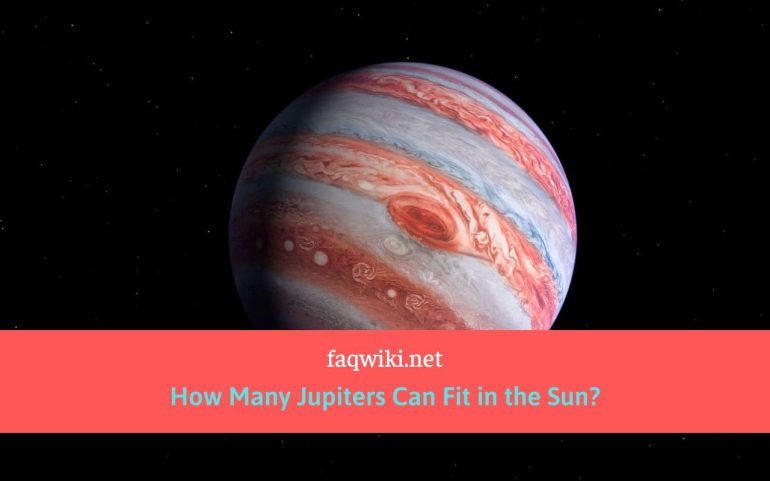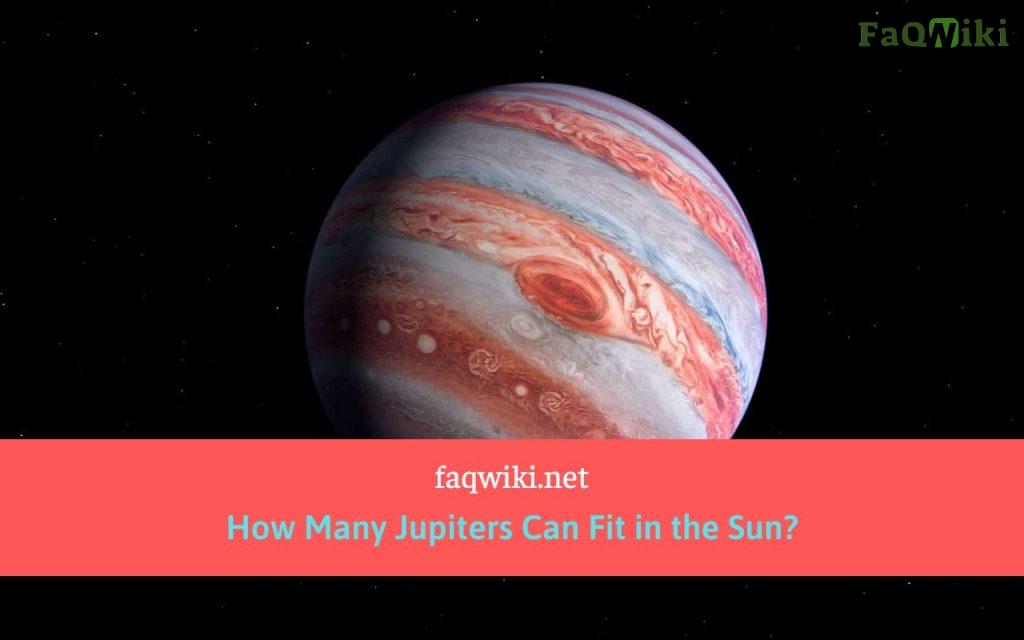How Many Jupiters Can Fit in the Sun?

How Many Jupiters Can Fit in the Sun? The question of how many Jupiters can fit in the Sun has been a topic of interest for astronomers and space enthusiasts alike. To answer this question, we need to consider the scale of our solar system and the physical properties of both Jupiter and the Sun.
Jupiter is the largest planet in our solar system, with a diameter of approximately 86,881 miles (139,822 kilometers). It is also the fifth planet from the Sun and is composed mainly of gas and ice. On the other hand, the Sun is the star at the center of our solar system, with a diameter of approximately 864,938 miles (1.39 million kilometers). It is composed mainly of hydrogen and helium gas and has a temperature of about 5,500 degrees Celsius (9,932 degrees Fahrenheit).

The Size of Jupiter
Jupiter’s size is impressive, making it the largest planet in our solar system. Its diameter is over ten times that of Earth, and it has a mass of 1.898 x 10^27 kg, which is two and a half times the mass of all the other planets in our solar system combined. Jupiter is also the most massive planet in the solar system, with a volume of approximately 1.4 trillion cubic kilometers.
Jupiter’s physical properties include a thick atmosphere, a strong magnetic field, and a large number of moons. The planet’s atmosphere is composed mainly of hydrogen and helium gas, with small amounts of other gases like methane, ammonia, and water vapor. The strong magnetic field around Jupiter is approximately 20,000 times stronger than Earth’s magnetic field, making it one of the strongest in the solar system. Jupiter has a total of 79 known moons, with four large moons, namely Io, Europa, Ganymede, and Callisto.
To measure Jupiter’s size, scientists use various instruments like telescopes and radar imaging. Radar imaging is especially useful in studying Jupiter’s atmosphere, while telescopes provide information on the planet’s physical features like its moons.
The Size of the Sun
The Sun is a star, and it is the largest object in our solar system. Its diameter is approximately 109 times that of Earth, and it has a mass of approximately 1.989 x 10^30 kg, which is more than 330,000 times the mass of Earth. The volume of the Sun is approximately 1.41 x 10^18 cubic kilometers, making it a giant in our solar system.
The Sun’s physical properties include a temperature of about 5,500 degrees Celsius (9,932 degrees Fahrenheit) at its surface and a core temperature of around 15 million degrees Celsius (27 million degrees Fahrenheit). The Sun’s atmosphere, which is composed mainly of hydrogen and helium gas, extends far beyond the visible surface and is called the corona.
To measure the size of the Sun, scientists use various methods like triangulation and the parallax method. Triangulation involves measuring the angular position of the Sun from different locations on Earth, while the parallax method uses the apparent shift in the position of the Sun relative to the background stars as Earth orbits around it.
Calculating the Volume of Jupiter and the Sun
To calculate the volume of Jupiter and the Sun, we use the formula for the volume of a sphere, which is V = (4/3)πr^3, where V is the volume, π is pi (approximately 3.14), and r is the radius of the sphere.
Using this formula, we can calculate the volume of Jupiter, which is approximately 1.4 trillion cubic kilometers. We can also calculate the volume of the Sun, which is approximately 1.41 x 10^18 cubic kilometers.
How Many Jupiters Can Fit in the Sun?
Now that we have the volumes of Jupiter and the Sun, we can determine how many Jupiters can fit inside the Sun. To do this, we need to compare the volume of Jupiter to the volume of the Sun.
If we divide the volume of the Sun by the volume of Jupiter, we get approximately 1,300,000. This means that approximately 1.3 million Jupiters can fit inside the Sun.
It is important to note that this calculation is based solely on the volumes of the two objects and does not take into account the density or mass of the objects. If we were to consider the mass of Jupiter and the Sun, the answer would be different.
The Density of Jupiter and the Sun
The density of Jupiter and the Sun is an important factor to consider when trying to understand their sizes and volumes. Density is defined as mass per unit volume and is typically measured in kilograms per cubic meter (kg/m^3).
Jupiter’s density is approximately 1,326 kg/m^3, which is less than one-fourth the density of Earth. This is because Jupiter is composed mainly of gas and ice, with a relatively small rocky core. The Sun’s density, on the other hand, is much higher, at approximately 1,408 kg/m^3. This is because the Sun is composed mainly of hydrogen and helium gas that is under extreme pressure and temperature, which causes the atoms to be packed tightly together.
The Mass of Jupiter and the Sun
The mass of Jupiter and the Sun is also an important factor to consider when trying to understand their sizes and volumes. Mass is defined as the amount of matter in an object and is typically measured in kilograms (kg).
Jupiter has a mass of approximately 1.898 x 10^27 kg, which is two and a half times the mass of all the other planets in our solar system combined. The Sun, on the other hand, has a mass of approximately 1.989 x 10^30 kg, which is more than 330,000 times the mass of Earth.
Conclusion
In conclusion, the question of how many Jupiters can fit inside the Sun is a fascinating topic that requires an understanding of the physical properties of both Jupiter and the Sun. While we can calculate the volume of the two objects and determine how many Jupiters can fit inside the Sun, it is important to note that this calculation does not take into account the density or mass of the objects.
Jupiter’s size is impressive, making it the largest planet in our solar system, with a diameter of approximately 86,881 miles (139,822 kilometers) and a mass of 1.898 x 10^27 kg. The Sun, on the other hand, is the largest object in our solar system, with a diameter of approximately 864,938 miles (1.39 million kilometers) and a mass of approximately 1.989 x 10^30 kg.
Understanding the size and physical properties of Jupiter and the Sun is essential in our quest to understand our solar system and the universe around us.
FAQs
How many Jupiters can fit inside the Sun?
Approximately 1.3 million Jupiters can fit inside the Sun, based on volume alone.
Why is Jupiter less dense than the Sun?
Jupiter is less dense than the Sun because it is composed mainly of gas and ice, with a relatively small rocky core. The Sun, on the other hand, is composed mainly of hydrogen and helium gas that is under extreme pressure and temperature, which causes the atoms to be packed tightly together.
How does the size of Jupiter compare to the size of Earth?
Jupiter is much larger than Earth. Its diameter is approximately 11 times larger than Earth’s, and its mass is over 300 times larger.
How does the size of the Sun compare to other stars?
The Sun is considered a medium-sized star. There are much larger stars in the universe, such as Betelgeuse, which is approximately 1,000 times larger than the Sun.
How do scientists measure the sizes of planets and stars?
Scientists use a variety of methods to measure the sizes of planets and stars. For planets, they can use techniques such as radar or observing the planet’s transit in front of a star. For stars, they use techniques such as spectroscopy, which involves analyzing the light emitted by the star.
Can the size of a planet or star change over time?
Yes, the size of a planet or star can change over time due to a variety of factors, such as internal processes or external influences from other objects in the solar system.
Is the density of a planet or star related to its size?
The density of a planet or star is not necessarily related to its size. For example, Jupiter is much larger than Earth, but its density is much lower due to its composition.
What is the significance of understanding the size and physical properties of Jupiter and the Sun?
Understanding the size and physical properties of Jupiter and the Sun is crucial in expanding our understanding of the universe and our place within it. It also helps scientists to develop better models and theories of how the solar system and the universe as a whole formed and evolved over time.
Conclusion
In conclusion, understanding the sizes and physical properties of Jupiter and the Sun is an important part of our ongoing exploration of the universe. While calculating the number of Jupiters that can fit inside the Sun is an interesting exercise, it is just one small part of the larger picture of understanding these two fascinating objects. By continuing to study Jupiter, the Sun, and other celestial bodies, we can deepen our knowledge and appreciation of the vast and complex universe we inhabit.
